
by Mark Smiley | Oct 24, 2018 | Main Articles
Flying Machines Impact Valley’s Workplace, Output; Altering Local Real Estate, Events, Construction, Mining
by Glen Richardson

Drones Over Denver: There are no specific rules for drones in Denver other than they are not allowed in parks or within a five-mile radius of any airport. They are allowed to fly at or below 400 ft., or about as high as a 40-story building.
To be sure drones aren’t yet as American as apple pie. Experts predict, however, that within the next decade unmanned aircraft systems (UAS) or drones will be as indispensable as the cell phones we carry everyday — tools that make us productive, safer and more connected.
Delivery of doughnuts to Denver’s mayor a year ago has thus far been the city’s single significant drone headline. Can’t drones wing it over the Rocky Mountains?
Despite creating little buzz locally, drone dealings are booming and doing double duty in Denver. Consider these examples:
Top Denver Deals
- Xcel Energy is the first utility in the nation to routinely fly drones beyond the operator’s line of sight as it surveys transmission lines around Denver;
- The University of Colorado at Denver offers a Drones 101 course that is the only academic one of its kind in the country;
- Valley drone company Juniper Unmanned has performed unmanned aircraft missions for companies on six continents;
- Drone companies did live demonstr
 ations on the roof of the Convention Center when Denver hosted XPONENTIAL, the world’s largest drone expo this summer; and
ations on the roof of the Convention Center when Denver hosted XPONENTIAL, the world’s largest drone expo this summer; and
- Denver-based Lockheed Martin is offering a $2 million prize in its Drone Challenge titled AlphaPilot.
Donut Delivery Dunked
Amazon, Google and Walmart are experimenting with drone delivery but despite the publicity it is not on Denver’s immediate radar. That’s in spite of the successful delivery of donuts to the mayor.
Why? Deliveries require a lot of work, more powerful drones, better battery life and extremely smart systems that can prevent collisions with people, aircraft and power lines.
Drones also need to be able to verify that they’re delivering something to you and that they’re leaving it in a safe place.
Out Of Sight Flights
In January of last year with FAA approval (2017), Xcel Energy began to operate drones within operators’ visual sight for power line inspections. The work established that drones improved productivity and safety without the use of trucks, helicopters or other utility equipment. Xcel inspects more than 320,000 miles of electricity and natural gas infrastructure to ensure the safety and reliability of its energy systems.
This summer the Federal Aviation Administration announced it had also authorized Xcel drone flights out of the operator’s line of sight. The FAA’s decision to allow these flights is unprecedented in the utility industry, the company says. “Xcel Energy is honored to be the first utility to conduct flights that will enhance grid reliability and safety for our employees and the public,” says Ben Fowke, chairman-CEO. “With this groundbreaking decision, we are advancing the use of technology that improves our efficiency and prov

Nation’s First: Xcel Energy is the first in the nation authorized to fly drones beyond the operator’s visual line of sight. Flights are within a designated area north of Denver to inspect assets.
ides cost savings for customers.”
The company is now routinely operating drones beyond the visual line of the operator’s sight within a designated area north of Denver. Licensed pilots remotely operate small, unmanned drones that look like helicopters weighing less than 55 lbs.
Drone Academics
Housed at CU Denver’s College of Engineering & Applied Sciences is a course titled Unmanned Aerial Systems. Often described as Drones 101, it is teaching a new generation of scientists about applications and research opportunities afforded by unmanned aircraft.
Taught by Jeff Cozart who also happens to be the chief executive officer of Juniper Unmanned — the leading drone company in the world — students are taught mission planning, UAS operations, collection procedures, data processing and analysis. Students also study the legal, ethical and economic implications of drone use.
Offered since 2014 and believed to be the only academic course of its kind in the country it has made Denver the nation’s scholastic leader in Unmanned Aerial Systems. Furthermore, Cozart is a member of the Aviation & Aerospace Science faculty at Metropolitan State University of Denver, where he teaches undergraduate courses in unmanned aircraft.
Business-Industry Leader
Valley drone company Juniper Unmanned is the world leader in unmanned aircraft missions for business and industry. Named the 2018 Colorado Company to Watch, the Golden-based firm has conducted operations on six of the world’s seven continents. Among the firm’s clients are Disney, AECOM, Caterpillar, Trimble, Rio Tinto, the U.S. Geological Survey, the Office of Surface Mining, the Bureau of Land Management and Department of Energy.
The company has completed work ranging from complex urban centers to remote, environmentally sensitive locations. Work is conducted from roads, bridges, earthen dams and power plants.
The company also provides drone solutions for commercial, federal, state, and military organizations. The company integrates best-in-class aircraft with the most advanced sensors. When combined with Juniper’s engineered processes, advanced software, and analytics, clients receive unmatched data and actionable intelligence to improve their business.
Has World’s Eye
After considering sites in San Francisco and New York, Propeller Aero, an Australian maker of drone software for construction and mining has landed in a 3,200-sq.-ft. space on Larimer St. downtown.
After closing on a $10 million round of funding in June, the Sydney-based company has hired a dozen Denver employees and expects the number to double. The firm was founded as a drone data company for mining, construction and waste-management in 2014.
Now, Propeller helps companies set up and fly a drone, then stitch together the photos it shoots into a 3D model to show customers how deep a hole has been dug, how much dirt is in a pile or the various gradients of a surface. In addition, the company produces AeroPoints, a hardware square plate that surveyors lay down on a site that collects data from drones.
Photos & Prizes
Commercial drones are revolutionizing Valley mining, construction and civil engineering. Drones are being used to survey building and the surrounding landscape. Equipped with cameras, GPS and rangefinder measurement tools they provide a detailed bird’s-eye perspective of projects. Some construction drones also have thermal imaging scanners that identify hot and cold spots on projects. A cold spot could indicate insufficient installation, hot spots an electrical problem. Drones can also inspect hard-to-reach areas such as the roofs of high-rise buildings.
Denver realtors are now using portfolios of drone photography to sell property. Drone film companies or realtors themselves shoot and use a diverse mix of aerial camera work from a variety of altitudes and angles. Drones are also now commonly used to shoot weddings and other Valley special events. Keeping their feet on the ground, companies such as Littleton’s Lupher Arts Wedding Motion Pictures use these flying machines to capture breathtaking shots.
Finally, Denver-based Lockheed Martin is offering drone enthusiasts a $2 million design prize. The Challenge: Design an artificial intelligence and machine-learning (AI/ML) framework capable of flying a drone though several professional drone racing courses without human intervention or navigational pre-programming.

by Mark Smiley | Oct 2, 2018 | Main Articles
The Extraordinary Journey Of Richard Robbins
by Charles C. Bonniwell

Watch Expert: Peter James, the worldwide mystery novelist, has utilized Richard Robbins’ expertise on early pocket watches in his book Dead Man’s Time and he recognized him by name as an “expert in timepieces in Denver, Colorado.”
Richard Robbins had lived what it looked like a perfect corporate executive life. After graduating from college he joined Kraft Foods, a Fortune 500 company. He traveled around the country doing important assignments as a key executive for over 20 years. He decided the constant moving was too stressful for his wife and two daughters, so he took a job as the president and CEO of a local bank in the Chicago area.
But after a decade as a bank president, Robbins went through a devastating divorce and he questioned whether he wanted to spend the rest of his productive working life in the role of a button down corporate executive. After a brief stint in New Zealand, he decided to move to the wilds of Colorado, i.e. Cherry Creek.
One of the verities of living a happy life is to find something you love and figure out a way to make money doing it. Robbins’ father had been a highly successful antique furniture dealer and Robbins had retained a love of beautifully made furniture. He

Handmade: Robbins has a passion for crafting walnut furniture and collecting and repairing early pocket watches from the 1700-1800 ca. His businesses can be found on the second floor of The District Shops, formerly occupied by Bed Bath & Beyond at 2500 E. First Ave in Cherry Creek North.
decided to start making desks and tables from the trunks of whole trees. The pieces of furniture can weigh as much as 100 pounds and are built to last generations.
He took space out at The District Shops in Cherry Creek Shopping Center which provides areas for artisans and other small businesses in the old Bed Bath and Beyond store. He crafts the fine furniture in the basement area of the shopping center at Robbins Woods.
In addition to his love of furniture, Robbins had a love for antique pocket watches. While in the Chicago area he had learned the ins and outs of pocket watches from a third generation Middle Eastern pocket watchmaker over a four-year period.
He decided to also turn that knowledge into a business venture. He acquired a large inventory of antique pocket watches from sales across the country and founded The Pocket Watch Shop leasing out separate space in The District. He repairs, buys, sells and trades the very best in antique pocket watches, specializing i

Many Talents: Richard Robbins has an unusual background which began with Kraft General Foods (20 years), followed by bank president in Chicago for 10 years. He now crafts all sorts of items out of different types of woods, including walnut and oak.
n timepieces made in America, England, France and Switzerland.
Robbins makes sure the timepieces are in perfect working order and meticulously researches, in the extensive timepiece library he has collected, the country of origin of each watch and the individual craftsman whose skill and inventive daring resulted in the pocket watch. When you acquires a pocket watch from The Pocket Watch Shop you are acquiring not only a timepiece, but a piece of history which has been carefully documented.
His expertise has become so well known that best-selling novelist Peter James extensively consulted him for his horological knowledge for his best seller Dead Man’s Time which has sold over 13 million copies. James repeatedly acknowledged and thanked Robbins for his help in the introduction to the novel.
Now a full-time Cherry Creek artisan, Robbins lives in a home in Washington Park along with his second wife and soul mate Kerry Moriarity who works as a custom travel agent in Cherry Creek. He stays closely involved with his two daughters, both of whom are graduates from the University of Colorado-Boulder, with one living in Denver and the other in the Chicago area.
To reach Richard Robbins call 847-370-0825, or visit www.antiquepocketwatchbuys.com.
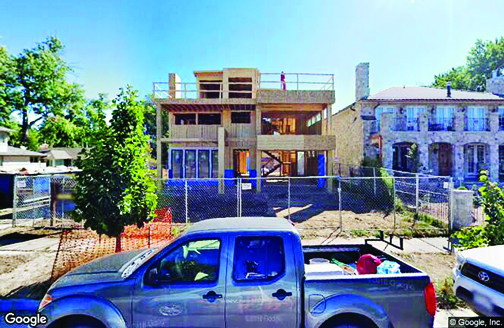
by Mark Smiley | Oct 2, 2018 | Main Articles
Permits For New Homes Are At A 13-Year Peak; Buyers Value Square Footage Over The Sticker Price
by Glen Richardson
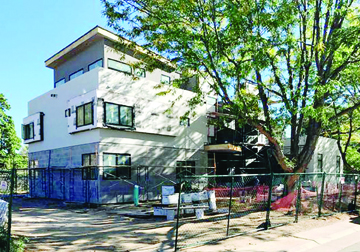
Bold Building Blocks: Builders in the Hilltop neighborhood are finding constant inspiration in replacing spacious old homes with bigger, brash designs.
Despite years of pushback by residents and multiple city ordinances that can delay the process, the scrape and construction of supersized single-family homes in Denver can reasonably be described as a building frenzy. Endlessly larger homes are replacing older homes and tidy rows of bungalows in virtually every Denver neighborhood.

Hilltop Status Symbol: Grand old Hilltop homes are being replaced with new builds such as this house on Fairfax St. designed by architect Collin Griffith and built this year by Forte Distinctive Homes.
Hitting levels that haven’t been seen in years, they are a source of controversy for their impact on gentrification and historic preservation. Furthermore many longtime residents say supersized homes are destroying the character of streetscapes while not respecting the context of the neighborhood. They also complain that as developers maximize the square footage of gigantic homes they not only sacrifice lawn and backyard size but also the views from nearby occupied houses.
Whatever you call it, the process is that developers or individuals find small older houses on large lots, scrape them away, build supersized homes on spec, and then sell them for unholy amounts of money. It’s a business. It’s a neighborhood. It’s a business and a neighborhood. In Wash Park, for example, at 600 S. Franklin St., Forte Distinctive Homes scraped a 1920s triplex and constructed a contemporary three-story home overlooking Washington Park Lake. The 4,800-sq.-ft. four-bedroom home on a corner lot sold in August for $3.66 million.
Permit Predicament
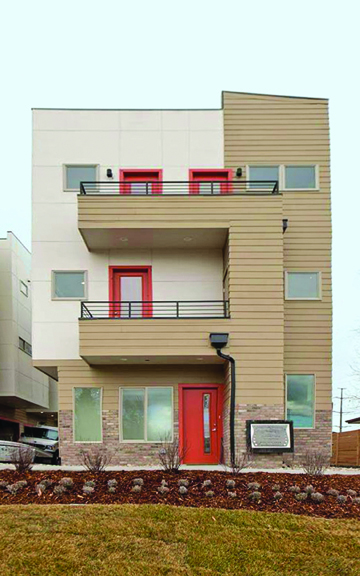
New Look Homes: Sustainable Design Build shows off streets of tall and slim townhomes such as this on streets off of West Colfax Ave.
Permits to build single-family homes are the highest they have been in 13 years. Community Planning & Development issued more than 35,000 permits in the first half of 2018, up roughly 2.1% from last year’s record-breaking frenzy. Realtors say there are currently about 500 new home construction and housing projects underway in Denver. That includes nearly 30 new home and townhome developments in Cherry Creek.
For buyers wanting to purchase a property with the house intact the wait time is often a dilemma. They are being told if they plan to scrape the home to build new, the delay time for a permit could be up to three months due to all the construction activity in the city.
The number of home scrapes completed in the last three years is pushing into new territory. Drive down what are previously untouched streets in a good number of neighborhoods today and you’ll see developers working on new projects that were bypassed for decades.
Changing Colfax
On West 13th St. a block south of West Colfax Ave., every street for 10 blocks has had at least one lot scraped and developed in the last three years. That puts the West Colfax neighborhood — where rows of townhomes are replacing 100-year-old bungalows — at or near the top for scrapes competing with hot spots in Wash Park and Hilltop.
Almost no part of town has had the block-by-block density of scrapes as West Colfax. As many as 1,200 structures have been demolished and replaced with new homes since 2016. Sustainable Design Build’s Mike McCarty has worked on five residential projects on three streets. He has built 34 new townhomes, averaging 1,200-sq.-ft. and priced between $400,000 and $500,000.

Scrape Off Sequel: Forte Distinctive Homes scraped a Wash Park 1920s triplex and replaced it with this four-bedroom home that sold in August for $3.66 million.
In 2015 he was buying lots with bungalows built between 1920 and 1940, paying $300,000 and $750,000, depending on the lot size. He puts four townhomes on the $300,000 lot and eight homes on those costing $750,000. In the last three years, however, he says the cost for land has risen from $50,000 to $100,000 per finished townhome unit.
Spacious Styles Scraped
Builders in historic Hilltop are scraping away already spacious homes in 22 different architectural styles — grand old homes in an assortment of Tudor, English, Mediterranean Revival, Georgian, Regency and Mid-Century Modern — and replacing them with gigantic newly built “status-symbol” classics.
The area is a one square-mile neighborhood bordered by Colorado Blvd. and Holly St., from 6th Ave. to Alameda. The eastern boundary is irregular, extending to Quebec St. at the north end, and encompassing properties on both sides of Monaco Pkwy. at the south end.
Combining indoor and outdoor space is the trend in these colossal new Hilltop houses that often start at $2.5 million or more. Architects and builders frequently scrape the house being demolished to the foundation, leaving  the base intact. That reduces the time to get permits and cuts the cost of installing new water and gas taps.
the base intact. That reduces the time to get permits and cuts the cost of installing new water and gas taps.
Pilfering Park Porches
With tree-lined streets and a 161-acre park and recreational area, Washington Park is one of the Denver’s favorite “hoods.” In the last couple of years, however, countless brick homes with quaint front porches have been scraped away for new builds that are popular and pricey.
The comfortable blend of historic homes adorned with pretty gardens, plants and landscaping, are constantly being replaced by radically bigger homes in more contemporary styles. Sprawling structures, moreover, are replacing lawns and landscaping in sizeable chunks at a good number of new build sites.
The trend is even more noticeable in East Wash Park as scraped lots are chock-a-block packed with big single-family houses. In fact the East Wash Park area now ranks third for the number of scrapes, trailing only upstarts Sloan’s Lake and Berkeley.
Scrape-Offs Stamina?
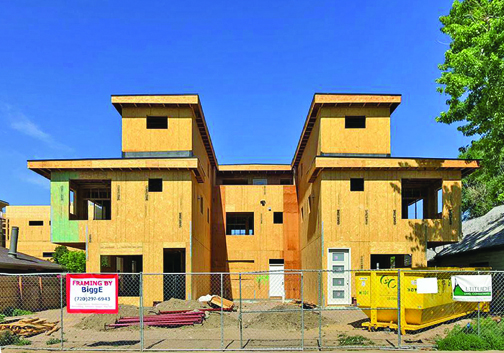
Rows Of Townhomes: Rows of under construction townhomes such as this are replacing 100-year-old bungalows on streets south of West Colfax.
Some homeowners see scrape and build as revitalizing old neighborhoods. Others, however, see it as people being pushed out and the historic nature of neighborhoods being destroyed, which does often happen. For others, scrape-offs can be an artistic and visual concern. Some contemporary architectural styles appear boxy and flaunt bold colors that aren’t attractive to everyone in a neighborhood.
For developers, however, scrape-offs are a business bonus created by an aging housing stockpile that is a lot smaller than the current consumer demands. Builders also argue that older homes are not suitable for today’s lifestyles or energy requirements.
Asking prices for supersized houses will likely continue to ascend, and this alone could eventually price builders out of a market they helped create. Much like cattle that have over-grazed a pasture, they will be forced to move on to even greener neighborhoods.
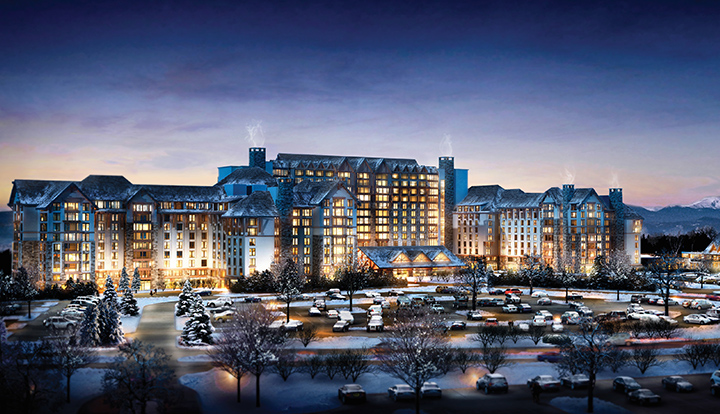
by Mark Smiley | Aug 24, 2018 | Main Articles
Denver Is Experiencing A Hotel Boom With Openings, Expansions And Renovation
by Glen Richardson

Super Size: This 1,500-room megaplex being built near DIA will be the state’s largest hotel. The sheer size of the Gaylord Rockies Hotel is likely to alter the Valley’s hotel, convention and spa landscape.

Cool Hand Hotel: The 3,600-sq.-ft. lobby of the Maven Hotel creates a seamless flow between work and play while serving as a neighborhood hub.
Denver is experiencing a hotel boom ignited by record-breaking occupancy that is escalating expansion and renovation in dozens of Valley neighborhoods. Moreover the upward trajectory in construction is forecast to continue despite some hiccups in recent months.
“In our lifetime, we’ve never seen this kind of demand, and it’s not slowing down,” MGM Grand’s Michael Dominguez told a meeting-convention group at Cherry Creek’s Halcyon Hotel this summer. Denver’s hotel occupancy rate of 73.7% is far above normal and nearly eight percentage points higher than the national average of 66%. Dominguez warns, however, that hotels are limiting service. “Nobody is building ballrooms.”
Denver’s hotel supply is forecast to increase by 4.6% this year, well above the 2% increase that is expected nationally. The 201-room Jacquard Hotel in Cherry Creek North is expected to finally open by September, bringing to five the number of hotels in the 16-block district. The 233-room Hilton Garden Inn Union Station is likely to be the next downtown hotel to open. By year’s end the megaplex 1,500-room Gaylord Rockies is scheduled to debut off of Pena Blvd. near DIA. Due to its sheer size it is almost certain to alter the Valley’s hotel, convention and spa landscape.
Growth Above 5%
Like Denver, hotel properties in other smaller cities such as Tampa, Charlotte, Phoenix, and Portland, are doing well. These are places where demand typically outpaces new construction and occupancies are at or near record high. Denver’s occupancy rates normally average around 65% over most 12-month periods. The 12-month occupancy rate in Denver is now more than 80% according to hotel research from CoStar Commercial Real Estate.
Demand for hotels in Denver is expected to grow 5.1% during 2018, pushing occupancy to new highs. Not only is demand expected to continue increasing this year but also through next year at more than twice the national average.
A total of 31.7 million visitors came to the Mile High City in 2017, a new record and the 12th consecutive year of growth. Denver gets only about 20% of the state’s visitors but accounts for half of all in-state tourism spending. Revenue last year was $6.5 billion. To be sure, the Valley’s abundant sunshine and outdoor recreation get a great deal of credit. Nevertheless — just as with the apartment boom — the so-called “green rush” of cannabis fans are luring a significant number of the city’s tourists, including mountain traffic headed to Denver hotels.
Third In Nation
Developers had 4,100 new hotel rooms under construction in 2017, ranking it fourth busiest city for hotel development. This year STR Hotel Market Data says there are 4,672 new hotel rooms under construction, ranking Denver third in the nation for most new hotel construction. Current U.S. leader
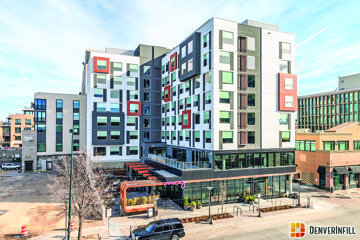
Creek Cool: Cherry Creek’s new Moxy Hotel adds a bright splash along Josephine St. The metal screening and random wood panels give this project a unique touch.
s are Nashville and Seattle.
“I think it’s almost impossible to say that Denver isn’t experiencing a hotel boom at the moment,” say residents who aren’t sure why. Others proudly proclaim Denver is becoming a very big U.S. tourist market because “what’s not to love about this city?”
Across Denver’s developing neighborhoods boutique hotels, like the Born, Maven and Moxy, are redefining the hospitality industry and filling a niche in a wide-ranging construction boom that is bringing dozens of new hotels and thousands of guest rooms to the city. The new aim developers say “is to lure travelers and entertain locals at the same time.”
Social Hubs
Hotels being built here now are becoming social and entertainment hubs, calling for flexible public spaces that provide a destination for travelers while also assimilating into the city’s local culture and its diverse neighborhoods. The building and interior, developers say, should be inviting yet uncommon enough to transport people from their daily routines.
Builders are working with art curators from the beginning of a pro

Ramblin’ Rose: One-of-a-kind touches include a custom, hand-carved hardwood front door make the new-yet-old-looking Ramble Hotel at 25th and Larimer a sparkling space.
ject to ensure art integrates fully into the design, instead of being an after-thought. That was the case with the recently opened Moxy Hotel in Cherry Creek. With 775 artworks and objects incorporated throughout the 170-room hotel, there’s a new surprise around every corner. The design and art work together to enhance the fun and funky millennial-minded concept that emphasizes social interaction. A boutique concept by Marriott, the building infuses the character of the surrounding upscale neighborhood while staying true to its “heart of a hostel” mindset.
The 50-room Ramble Hotel housed in a new-yet-old-looking brick building at 25th and Larimer is another case in point. Ryan Diggins of Gravitas Development Group added one-of-a-kind touches include a custom, hand-carved hardwood front door, chicken-wire glass from Rockefeller Center, and a grand lobby bar built by local craftsman Brian Trybus. Furthermore, LA’s Avenue Interior Design incorporates elegant furnishings, fabrics and accessories. At Sage Hospitality’s 172-room
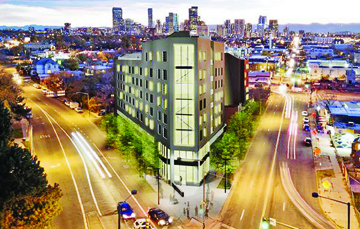
Hybrid Hip: A trio of developers wants to build a hybrid hotel in RiNo, with 161 units renting for as short as a night or as long as a year.
Maven Hotel in the Dairy Block public space has been taken to an imaginative artistic level. The hotel’s 3,600-sq.-ft. lobby creates a seamless flow between work and play while serving as a neighborhood hub. It connects two eateries to an adjacent office building and can also serve as an adaptable event space or a vendor alley while also providing numerous dining options. Guest rooms feature a rich color palette and loft-style décor with high ceilings and large windows.
What’s Next?
A trio of local developers is proposing a hybrid residential complex in RiNo, with 161 units renting for as short as a night or as long as a year. Peak Development Group, Slipstream Properties and Kaplan Cos. want to build the yet-to-be-named eight-story project on Walnut St., a short walk from the 38th and Blake light rail station. Some floors would have units rented on a nightly or weekly basis, the companies say. Units on the remaining floors would be for more long-term tenants. The units would be a mix of studios and one-bedrooms, ranging in size from 350 to 650-sq.-ft. The three firms purchased the 0.32-acre triangular parcel at 3724 Walnut St. for $2.1 million in June. The parcel includes a two-story building, constructed in 1890, that the developers plan to preserve, with new construction flanking it on both sides. They’ve since spent another $1.1 mill

Spring Elements: Marriott is building the Element Hotel with restaurant at 14th Ave. & Elati that’s expected to open next spring.
ion on two adjacent parcels.
The Rossonian — an unoccupied Five Points landmark — will be renovated into a 41-room boutique hotel, complemented by a basement jazz club and ground floor restaurant-lounge. The eatery-bar venue will be named Chauncey’s for Denver basketball legend and project partner Chauncey Billups. Developer Paul Books plans to add a fourth floor, housing seven rooms and balconies on top of the existing three-story building. Palisade purchased the hotel in August for $6 million.
Here are a few other new hotels currently on the drawing board: Element Hotel by Marriott is building a 157-room studio, 1 and 2-bedroom inn with restaurant that’s expected to open at 14th Ave. and Elati next spring. Plans have been filed to build a 150-room Ballpark Hotel at 2250 Blake St. Also a 546-room Focus Hotel is slated for a 2021 debut at 14th and Stout. Finally, GFI Development is planning to build an Ace Hotel on 19th Ave. between Grant and Logan.

by Mark Smiley | Aug 24, 2018 | Main Articles
by Ruthy Wexler

Your DPS School Board Having Fun: Left to right: Barbara O’Brien, Lisa Flores, Jennifer Bacon, Allegra “Happy” Haynes, Carrie A. Olson PhD, President Anne Rowe, and Angela Cobian. “We need to find a wonderful leader,” says President Rowe, “to take this district forward” — a goal with which no one disagrees. But the way to that goal is not obvious. Even longtime pro-reform supporter O’Brien admits, “What is hard about this work, is that we can all imagine a great outcome … but we’re not sure how to get there.”
Over his 10-year reign, Denver Public Schools (DPS) Superintendent Tom Boasberg gained national prominence by his zealous implementation of reform educational measures. In recent years, opposition to those measures has grown — which is why, when Boasberg announced on July 17 that he was stepping down, over 22 local groups swung into action and collaborated on a Community Manifesto that, among other items, proclaimed their right to help select the new superintendent.
On July 30, at the first public meeting addressing the “super search,” the seven-member DPS School Board seemed to agree that community input was essential. “We are listening; keep those emails coming,” said new Board member Carrie Olson, as the other six nodded agreement. But their cheerfully united front masked the fact that this Board, with their divergent beliefs, wil

Activist: One of the activists who signed the Community Manifesto and delivered it on July 27 was Kerrie Joy, whose poem about community strength in education elicited cheers. “We are listening,” she proclaimed, “but we will also be heard.”
l soon face the central, inescapable question: Should they choose a candidate who will continue Boasberg’s policies? Or should they choose someone who wants to lead from a different direction?
Reform Or Not Reform: That Is The Question
Denver schools were widely believed to be failing when DPS Superintendent Michael Bennett began radically changing the city’s educational system with reform measures like welcoming charters, closing schools and using high-stakes testing to shape decisions. “We thought we were creating a system that served students first,” recalls Theresa Pena, School Board member from 2003-2011, who has recently written of her disappointment in DPS results.
When Bennett was picked to fill a U.S. Senate seat in 2009, the Board chose Boasberg to continue his policies.
But 10 years later, the main question — have reform policies achieved their stated goal of closing achievement gaps between low-income and more affluent students? — has no clear answer. In a district where students of color comprise almost three-quarters of the population, the answer depends on whom you ask. Observing recent data that shows DPS’s achievement gaps still gaping widely, Pena believes the district hasn’t gone far enough, while grassroots groups like Our Denver Our Schools (ODOS) and Our Denver Our Voices (ODOV) believe DPS resources should now go to improving neighborhood schools. Van Schoales, CEO of the pro-reform group A+ Colorado, says, “Going back to the way things were would be a huge mistake.”
Changing the makeup of the School Board is the only way citizens can affect change. This past election saw two candidates critical of the district’s current strategies, Olson and Jennifer Bacon, win seats on a previously all-reform board.
If You Wanna Be Superintendent …
On August 3, the Board passed a resolution, saying that the search would be internal as well as external (fueling rumors that Susanna Cordova, who once subbed for Boasberg, might be chosen); announcing the search’s timeline (candidates must submit applications by September 14; the Board will name finalists by October 15); and stating that an outside consultant would be used. On August 13, DPS hired the Illinois-based firm of Hazard, Attea & Associates, contracting to pay them $30,000 plus expenses.
Community, Speak!
Anxious that the tight timeline might prevent their voices from being heard, many teachers and parents shared with this reporter what they wanted in a new superintendent. The most frequently expressed opinion was that he or she be an educator. “They say the best manager is someone who knows the industry,” said ESL teacher Lisa W. “Well, the industry in teaching is … teaching.”
Sarah Dieter, a first grade paraprofessional, wanted, “… someone who has actually taught in a classroom under these budgetary and other restrictions.”
“Only an experienced teacher understands the beautiful complexities of learning,” said Andrea, who teaches Language Arts.
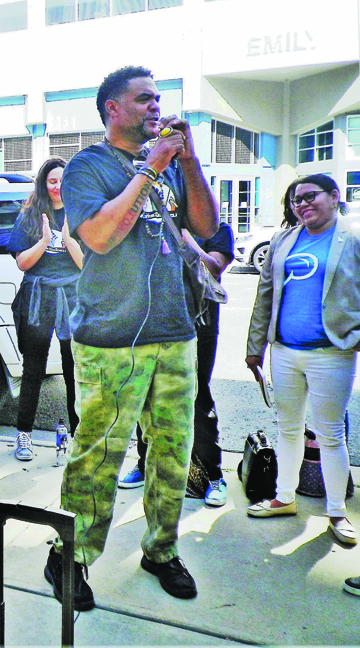
Breaking Our Chains: Among the educational activists who collaborated on the Community Manifesto is “Soul” Asemu, who stated, “Education is the civil rights issue of our time.” Asemu is the Executive Director of Breaking Our Chains, an organization which “focuses on supporting underserved students of color.”
One DPS father: “Businessmen have no business being superintendents.” History teacher Troy Valentine: “It’s not helpful when people with business degrees supervise teachers.”
“We want someone who gives educators confidence to use their common sense,” said DPS parents Gina and Mark O’Brien, whose six-year-old son’s classroom became overheated from a faulty valve, but, “No one would fix it, because it wasn’t next on the list.”
“Someone who views teachers as the foundation,” said first grade teacher Suzanne Hernandez.
“The new superintendent should insist on well-trained teachers and then trust those teachers to understand the needs of their students,” said Amy Turino, a 16-year veteran who now coaches colleagues.
Kindergarten teacher Julie W.: “Someone who really wants that job! Not as a stepping stone into politics. A wonderful job for an educator to use all they know. A woman, if possible.”
DPS parent Debby Thornburg James: “I want the new superintendent to LOVE public schools, so that she or he can immediately begin restoring them in every Denver neighborhood where charter schools now squat in our publicly owned school buildings.”
Councilwoman Deborah Ortega, whose grandchildren attend DPS: “Someone not so wrapped up in testing …”
Principal Sheldon Reynolds suggested that the new superintendent should, “… build on structures developed by Tom [Boasberg] over the past decade rather than dismantle them … The challenge is how do you honor the work (policies and practices) from Tom’s era while crafting a new vision [that would correct] … unintentional consequences of the prior work…”
Promises, Promises
“When I read that Boasberg was stepping down,” Ortega recalls, “I re

Unpopular Leader: The widely unpopular Superintendent of the Denver Public Schools Tom Boasberg, center, stepped down in July 2018 after 10 years at the helm. The last year has been riddled with controversy which some say prompted his resignation.
alized, ‘The community needs to impact this decision.’” The Community Manifesto she helped facilitate, signed by dozens of local organizations and individuals, asks that the new superintendent be “a transformer, not a reformer.” The document was delivered on July 27 to the Board, which so far, has not mentioned it.
The DPS board has the responsibility of choosing Boasberg’s replacement — and thus, the future of Denver’s 92,600 students. The community, says James, “… has been promised the opportunity to give input into this decision, which affects our children most of all. We are waiting.”
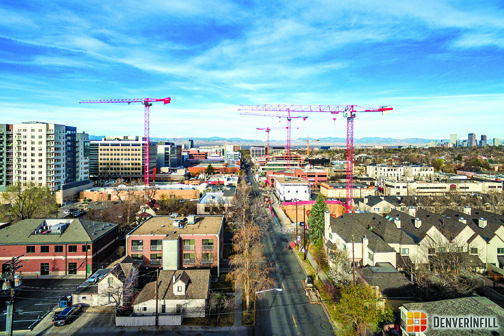
by Mark Smiley | Jul 20, 2018 | Main Articles
Councilman New Drafts Construction Management Ordinance, Says Size, Complexity Exceed City’s Ability Or Will To Control
by Glen Richardson
Denver is undergoing its largest construction boom in modern times with Cherry Creek North at the epicenter. Like a jackhammer the excessive construction is causing serious detrimental effects to surrounding businesses, residents and visitors. Moreover, the construction trend is on the rise in adjacent neighborhoods plus sections of downtown.
“The lack of support and assistance to small business retailers and neighborhood residents by development owners, construction management, construction workers and Denver Public Works justifies the need for stronger construction management policies by the City,” concludes City Councilman Wayne New. Council members Albus Brooks with his similar construction problems in RiNo and Paul Kashmann with the same issues in his neighborhoods have been supportive to the proposed changes.
The first term councilman, who is also a Cherry Creek North resident, say he has determined that “a City Council ordinance is required to enhance existing Public Works construction management policies that will manage construction projects more efficiently and effectively.” He tells the Chronicle it is his hope such an ordinance will mitigate the trials and tribulations businesses and residents in Cherry Creek have experienced for the past three years. “The ordinance will give Public Works greater flexibility to manage projects of varying size and complexity.” While the focus is on Cherry Creek construction he adds, “these recommendations can and should be applicable to construction project in all city areas.”
Collapse At Public Works
The number of Cherry Creek North construction projects that have been initiated simultaneously and in a relatively short period of time is staggering: The district has seen four major projects completed, 10 are underway, plus two to three new projects are set to begin within the next 12 months. Those construction projects don’t take into account rhe ones completed or under construction in the contiguous Cherry Creek East and Golden Triangle areas.
Impact of the Cherry Creek construction volume has been a serious blow to district parking. Moreover, New notes that the implementation of paid parking at the Cherry Creek Shopping Center has increased district customer and neighborhood parking concerns.
“There is no doubt now that the problems have resulted from Public Works’ inability to require pre-permitting and pre-construction planning and construction management agreements regarding area traffic flow, street closures, parking meter management, defined offsite parking arrangements, noise mitigation, trash prevention and collection.”
Sending Wrong Message
The lack of routine and timely construction meetings with the involvement of all parties has also hindered critical discussion on construction project issues and plans, according to New.
Such meetings, he believes, “would have prevented or mitigated problems and difficulties for businesses and residents before they occurred.”
The inability of construction companies and city officials to address these problems and issues has discouraged the desire of shoppers and business customers to visit areas where construction is underway. Furthermore, New bemoans, “It has sent a citywide message to avoid Cherry Creek and its construction problems.” The impact, he says is clear: “Small business retail sales have declined, residential quality of life disrupted and neighborhood parking hindered.”
Many small businesses have either closed or are struggling to stay in business. Cherry Creek residents are questioning whether the traffic congestion, traffic flow disruptions and parking limitations will decrease or can be managed. Thus many residents are contemplating if remaining in the neighborhood will be possible or desirable.
Steps To Improvement
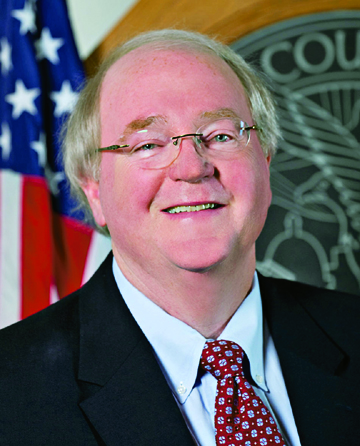 The ordinance being drafted by Councilman New has more than a dozen recommendations for improvements. They are being created now because as New asserts, “It is very apparent they are required to strengthen current City construction management policy and provide additional policies for improvement.”
The ordinance being drafted by Councilman New has more than a dozen recommendations for improvements. They are being created now because as New asserts, “It is very apparent they are required to strengthen current City construction management policy and provide additional policies for improvement.”
Top of the list is the issue of Excessive Construction within a Defined Area. Reason: The compounding effects of excessively large volumes of work have caused extreme hardships on surrounding businesses, residents, visitors and others within the area. Recommendation: When multiple projects are initiated that impact pedestrian safety and traffic management Public Works will strictly enforce policies and procedures to balance and mitigate effects on commercial and residential communities. This includes strict sidewalk protections; limit the permitting of street-lane closures and temporary one-way streets that grant favorable treatment to construction projects.
The Councilman also believes that Planning, Communication & Notification must be compulsory. Reason: Business and community leaders are not involved in project discussions. Moreover, there is insufficient notification to all parties when activities affecting business operations and traffic flow will occur. Recommendation: Full street closures for an extensive time period will not be allowed. Closure of a street for up to three days may be considered for safety reasons. A graduated fee per day would be imposed on contractors failing to end approved closures.
Added Reform Measures
These additional reforms, condensed for publication, are included in the ordinance being drafted by New:
Pedestrian Sidewalks: If construction occurs on a block, one side of the street must be open. When construction occurs on both sides of the street, a wooden covered walkway must be installed on at least one side of the project. Walkways must be sturdy, waterproofed and adequately lighted for nighttime use.
Construction Worker Parking: A defined plan for every project must be submitted to Public Works prior to receiving a building permit. Contractors must provide an agreement for contracted offsite parking with financial incentives, and penalties for non-compliance. Plan to be forwarded to businesses, neighborhood organization and Council member.
Infrastructure & Streetscape Damage: It is not a taxpayer responsibility to repair damage to city streets and streetscapes created by construction projects. Construction project performance bond must include the cost of repairing, replacing streets and streetscapes to their original condition.
Patch Parking Problems
Parking District Development: Proposed district would operate and fulfill all prescribed City regulations and requirements but would not be responsible for parking meter collections. Management of City parking activities is not currently coordinated and managed by a single City division.
Parking Meters: Use of parking meter bags for construction purposes must be included in pre-construction planning discussions in order to make business and neighborhood leaders aware of any pending disruptions. Meter bagging would not be allowed for more than a continuous three-day period.
Parking Enforcement & Signage: Parking enforcement and ticketing must be performed in all neighborhoods on a regular 2-hour basis. Signage that informs parkers of the proper distance for alley entrances and street intersections must be installed. An implementation and budget plan must be developed for a five-year completion time frame.
Noise, Trash & Traffic
Noise & Trash: Contractors must provide construction site trash and cigarette butt receptacles directly outside of construction sites. Contractors must pay local business organizations for the offsite area collection and removal of trash and cigarette butts daily.
Traffic & Pedestrian Signage: Contractors must remove all traffic and pedestrian management signs, cones and barricades from the public right-of-way within 24-hours when not in use.
Coordination With City & Business Guidelines: Recommendations for improvement must be coordinated with existing construction mitigation plans and business area guidelines. Differences should be reconciled and final improvements guided by their efficiency, effectiveness, balance and greatest positive impact.
Construction Epicenter: Towering cranes over Cherry Creek hint at the number of construction projects that have been initiated. The district has seen four major projects completed, 10 are underway, plus two to three new projects are set to begin within the next 12 months.
Denver City Councilman Wayne New
Street Shutdown: Cherry Creek North street closures are damaging business operations and disrupting traffic flow. One block of Saint Paul St. where a bank and other businesses are located was closed for two months.
Lack Of Planning: By not communicating and coordinating construction activities Public Works contributes to the lack of community notice and inability to mitigate business operational problems.
Construction Conquest: Use of parking and traffic lanes for additional construction project space contributes to potential pedestrian and traffic flow safety problem.�
Gotta Go Other Way: Temporary one-way street arrangements give favorable treatment to construction projects and have a negative effect on businesses, residents and visitors.
Closed Sidewalk Epidemic: Booming development should bode well for people who walk. In Denver, nevertheless, people are encountering more and more closed sidewalks in construction zones.


 ations on the roof of the Convention Center when Denver hosted XPONENTIAL, the world’s largest drone expo this summer; and
ations on the roof of the Convention Center when Denver hosted XPONENTIAL, the world’s largest drone expo this summer; and






















